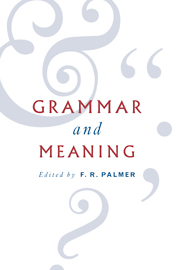Book contents
- Frontmatter
- Contents
- List of contributors
- Foreword
- 1 Polysemous relations
- 2 Fields, networks and vectors
- 3 Syntax, semantics, pragmatics
- 4 Natural-language interpretation as labelled natural deduction
- 5 Three levels of meaning
- 6 Does spoken language have sentences?
- 7 Grammaticalisation and social structure: non-standard conjunction-formation in East Anglian English
- 8 German Perfekt and Präteritum: speculations on meaning and interpretation
- 9 The possessed
- 10 Complement clauses and complementation strategies
- 11 Grammar and meaning
- John Lyons: publications
- Index
2 - Fields, networks and vectors
Published online by Cambridge University Press: 30 January 2010
- Frontmatter
- Contents
- List of contributors
- Foreword
- 1 Polysemous relations
- 2 Fields, networks and vectors
- 3 Syntax, semantics, pragmatics
- 4 Natural-language interpretation as labelled natural deduction
- 5 Three levels of meaning
- 6 Does spoken language have sentences?
- 7 Grammaticalisation and social structure: non-standard conjunction-formation in East Anglian English
- 8 German Perfekt and Präteritum: speculations on meaning and interpretation
- 9 The possessed
- 10 Complement clauses and complementation strategies
- 11 Grammar and meaning
- John Lyons: publications
- Index
Summary
The traditions of semantics in linguistics and philosophy have overlapped somewhat in recent decades, but earlier trends and treatments in each discipline have dealt with rather different aspects of meaning. In this essay we hope to unite some of these different threads. It is a special pleasure to contribute to a volume in honour of Sir John Lyons, who has made major contributions to a theory of meaning.
In Lyons' early work (1963, 1968) the meaning of a word was conceived of as its place in the lexical network of the semantic field to which it belonged. A theory of reference - to hook up language and the world - is also a necessary part of the semantic enterprise. We wish to explore how theories of sense and reference can be related.
A word on terminology
The word meaning is used in many different ways, in both philosophy and linguistics. It has been used to describe extralinguistic relationships, that is, between an expression and something in the external world, and intralinguistic relationships - between expressions within a language or between those in different languages. Given the ambiguity of the word meaning, we shall try to avoid using this word, instead employing reference or denotation for word-world connection, and sense, which Lyons has defined as the ‘place in a system of relationships which it contracts with other words in the vocabulary’ (Lyons, 1968: 427).
Information
- Type
- Chapter
- Information
- Grammar and MeaningEssays in Honour of Sir John Lyons, pp. 26 - 47Publisher: Cambridge University PressPrint publication year: 1995
Accessibility standard: Unknown
Why this information is here
This section outlines the accessibility features of this content - including support for screen readers, full keyboard navigation and high-contrast display options. This may not be relevant for you.Accessibility Information
- 7
- Cited by
